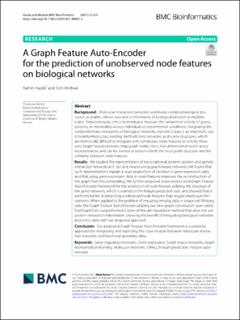| dc.contributor.author | Hasibi, Ramin | |
| dc.contributor.author | Michoel, Tom | |
| dc.date.accessioned | 2022-04-04T08:10:10Z | |
| dc.date.available | 2022-04-04T08:10:10Z | |
| dc.date.created | 2021-11-01T10:26:40Z | |
| dc.date.issued | 2021 | |
| dc.identifier.issn | 1471-2105 | |
| dc.identifier.uri | https://hdl.handle.net/11250/2989431 | |
| dc.description.abstract | Background
Molecular interaction networks summarize complex biological processes as graphs, whose structure is informative of biological function at multiple scales. Simultaneously, omics technologies measure the variation or activity of genes, proteins, or metabolites across individuals or experimental conditions. Integrating the complementary viewpoints of biological networks and omics data is an important task in bioinformatics, but existing methods treat networks as discrete structures, which are intrinsically difficult to integrate with continuous node features or activity measures. Graph neural networks map graph nodes into a low-dimensional vector space representation, and can be trained to preserve both the local graph structure and the similarity between node features.
Results
We studied the representation of transcriptional, protein–protein and genetic interaction networks in E. coli and mouse using graph neural networks. We found that such representations explain a large proportion of variation in gene expression data, and that using gene expression data as node features improves the reconstruction of the graph from the embedding. We further proposed a new end-to-end Graph Feature Auto-Encoder framework for the prediction of node features utilizing the structure of the gene networks, which is trained on the feature prediction task, and showed that it performs better at predicting unobserved node features than regular MultiLayer Perceptrons. When applied to the problem of imputing missing data in single-cell RNAseq data, the Graph Feature Auto-Encoder utilizing our new graph convolution layer called FeatGraphConv outperformed a state-of-the-art imputation method that does not use protein interaction information, showing the benefit of integrating biological networks and omics data with our proposed approach.
Conclusion
Our proposed Graph Feature Auto-Encoder framework is a powerful approach for integrating and exploiting the close relation between molecular interaction networks and functional genomics data. | en_US |
| dc.language.iso | eng | en_US |
| dc.publisher | BioMed Central | en_US |
| dc.rights | Navngivelse 4.0 Internasjonal | * |
| dc.rights.uri | http://creativecommons.org/licenses/by/4.0/deed.no | * |
| dc.title | A Graph Feature Auto-Encoder for the Prediction of Unobserved Node Features on Biological Networks | en_US |
| dc.type | Journal article | en_US |
| dc.type | Peer reviewed | en_US |
| dc.description.version | publishedVersion | en_US |
| dc.rights.holder | Copyright 2021 The Author(s) | en_US |
| dc.source.articlenumber | 525 | en_US |
| cristin.ispublished | true | |
| cristin.fulltext | original | |
| cristin.qualitycode | 2 | |
| dc.identifier.doi | 10.1186/s12859-021-04447-3 | |
| dc.identifier.cristin | 1950074 | |
| dc.source.journal | BMC Bioinformatics | en_US |
| dc.identifier.citation | BMC Bioinformatics. 2021, 22, 525. | en_US |
| dc.source.volume | 22 | en_US |

